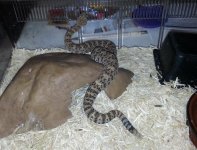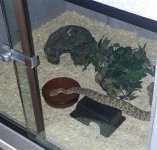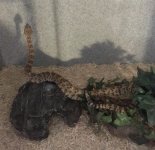-
Hello!
Either you have not registered on this site yet, or you are registered but have not logged in. In either case, you will not be able to use the full functionality of this site until you have registered, and then logged in after your registration has been approved.
Registration is FREE, so please register so you can participate instead of remaining a lurker....
Please be certain that the location field is correctly filled out when you register. All registrations that appear to be bogus will be rejected. Which means that if your location field does NOT match the actual location of your registration IP address, then your registration will be rejected.
Sorry about the strictness of this requirement, but it is necessary to block spammers and scammers at the door as much as possible.
You are using an out of date browser. It may not display this or other websites correctly.
You should upgrade or use an alternative browser.
You should upgrade or use an alternative browser.
Accidental find in Riverside
- Thread starter Lovin2act
- Start date
Lovin2act
I gave my wife herps
How did his first FT feeding go? I mean, what was the process, and did he strike it, how many times, and then wait for it to die? I always thought it was interesting how my tricolor hog would envenomate a FT mouse for 20 minutes before starting to swallow.
Yes he did strike just once as I did an in cage tong feeding. I warmed up the feeder and then used the tongs to dance him around a bit right in front of the little guy. He took a swig at it with the little daggers and then I kinda danced the hopper around a bit and then dropped it right in front of him. After a couple minutes of yawing and procrastinating, he started sniffing around and went to go eat it up just like he had been doing this for years. He did accidentally drop it off the top of the cave rock he was on and looked all confused as to where it went, but he figured it out on his own after some searching around and then finished up
Lovin2act
I gave my wife herps
Nice to hear the f/t went over well
Cute Engagment pics!
Thankya!:licklips:
Nanci
Alien Lover
I was interested in the significance of the yawning behaviour, and found this really cool research paper! I hope you can access it. I'm at an academic site...
Rattlesnakes will trail prey that they themselves have struck for up to 24 hours. They will not trail unstruck prey or prey struck by other rattlers.
For our study, the prestrike behaviors observed in the baseline studies (no strike)
appeared to be analogous to ambush behavior in the wild wherein the snake
initially locates an area with high prey density and then sets up in ambush
(Duvall et al., 1985, 1990). During prestrike, there is little advantage for a
snake to indiscriminately follow odors trails of non-envenomated mice.
In this context, the yawning behavior observed, especially during baseline
experiments, is provocative. It has been argued that this yawning behavior
serves a number of functions, wiping the fangs, priming the musclo-skeletal
system for a strike, and vomeronasal function (Graves & Duvall, 1985;
Young, 1993; Schwenk, 1995). This last function seems plausible in these
rattlesnakes. The yawning during baseline experiments correlates with the
time the rattlesnake might be expected to attempt to gather environmental
odors in a refreshed vomeronasal organ (VNO). The olfactory epithelium
can be refreshed by increased ventilation. But the blindended vomeronasal
organ might retain old odors. Once the VNO becomes saturated with odors,
making odor discrimination difficult, the snake yawns and thus causes a
pressurec hange in the mushroom-bodiedV NO. This, in a sense, would clear
the VNO, allowing for a sampling of new odors (Schwenk, 1995)
Rattlesnakes will trail prey that they themselves have struck for up to 24 hours. They will not trail unstruck prey or prey struck by other rattlers.
For our study, the prestrike behaviors observed in the baseline studies (no strike)
appeared to be analogous to ambush behavior in the wild wherein the snake
initially locates an area with high prey density and then sets up in ambush
(Duvall et al., 1985, 1990). During prestrike, there is little advantage for a
snake to indiscriminately follow odors trails of non-envenomated mice.
In this context, the yawning behavior observed, especially during baseline
experiments, is provocative. It has been argued that this yawning behavior
serves a number of functions, wiping the fangs, priming the musclo-skeletal
system for a strike, and vomeronasal function (Graves & Duvall, 1985;
Young, 1993; Schwenk, 1995). This last function seems plausible in these
rattlesnakes. The yawning during baseline experiments correlates with the
time the rattlesnake might be expected to attempt to gather environmental
odors in a refreshed vomeronasal organ (VNO). The olfactory epithelium
can be refreshed by increased ventilation. But the blindended vomeronasal
organ might retain old odors. Once the VNO becomes saturated with odors,
making odor discrimination difficult, the snake yawns and thus causes a
pressurec hange in the mushroom-bodiedV NO. This, in a sense, would clear
the VNO, allowing for a sampling of new odors (Schwenk, 1995)
Lovin2act
I gave my wife herps
Forgot about this thread and have neglected it pretty badly!
So here are a couple shots that I snapped that are sort of more recent than the ones on the first page.
The first was taken in January during meal time, the second and the third were taken in May
He is taking f/t meals without any hesitation now. In fact he takes the meals right off the tongs and starts eating immediately...no time for silly dancing dead mice or after strike yawns
So here are a couple shots that I snapped that are sort of more recent than the ones on the first page.
The first was taken in January during meal time, the second and the third were taken in May
He is taking f/t meals without any hesitation now. In fact he takes the meals right off the tongs and starts eating immediately...no time for silly dancing dead mice or after strike yawns
Attachments
MotleyMedusa7
lovin' my sweet corns
wow he's looking good-glad he's doing well for you 
I don't think I would ever want to own a rattlesnake, but he is a beauty! I love his speckles.
Lovin2act
I gave my wife herps
wow he's looking good-glad he's doing well for you
Yeah he really is growing like a weed, and I am super stoked how well he is doing also!
yes, wow. I just got to read this thread now and its very neat!
thanks for the update!
Glad you enjoyed reading about his little story here
I don't think I would ever want to own a rattlesnake, but he is a beauty! I love his speckles.
I never wanted to either until this little clobber of scales pushed his way into my life
Justine66
Cuddling with Colubrids<3
sweet! 
thanks a lot! I have always had a soft spot for rattle snakes, I wouldn't dare keep one personaly.. but I have umpteen respect for them as far as any reptiles go.. he's lucky to have you! I just hope that he keeps his appreciation by also keeping his mellow manner for you!
thanks a lot! I have always had a soft spot for rattle snakes, I wouldn't dare keep one personaly.. but I have umpteen respect for them as far as any reptiles go.. he's lucky to have you! I just hope that he keeps his appreciation by also keeping his mellow manner for you!
Lovin2act
I gave my wife herps
sweet!
thanks a lot! I have always had a soft spot for rattle snakes, I wouldn't dare keep one personaly.. but I have umpteen respect for them as far as any reptiles go.. he's lucky to have you! I just hope that he keeps his appreciation by also keeping his mellow manner for you!
ME TOOOO!!!!
Lovin2act
I gave my wife herps
Haha thanks! I too would never have dared to do this, but this situation just kinda turned into what it is and I often tell myself, what the heck are you doing with this guy! But then I go see him and he just kinda melts me down and I am so glad I got to be the one who saved him!



